Today’s intense macro-economic and geopolitical uncertainty may soften demand for seaborne dry bulk commodity imports but may also mute dry bulk ship orders over the next quarters.
It has been just over a month since tariffs were announced by President Trump, and despite recent positive developments with China and the UK, it is anyone’s guess as to the final outcome. Because of the uncertainty of tariff duration, we believe it is too early to understand the long-term implications. Yes, container markets have seen a significant near-term US tariff impact, Chinese factory orders are down, and US retailers and consumers may see a near-term supply crunch, but now we have a 90-day pause with tariffs significantly reduced.
For dry bulk demand, the near-term tariff impact appears rather different. Since the spike in the Baltic Dry Index during the fourth quarter of 2021, the BDI has been weak (as it was for a decade prior to 2021) despite good global growth, particularly post COVID. However, sustained US tariffs could soften dry bulk commodity demand from China, the largest consumer.
China relies on exports for economic growth. According to the World Bank, global consumption accounts for roughly 75% of gross domestic product (GDP), with the remaining 25% driven by investment. In China, consumption is only 54% of GDP, while investment accounts for 43%.2 China has been facing varying degrees of price deflation for eight consecutive quarters. Just prior to the 90- day reduction in tariffs announced this week, fewer Chinese goods were being exported to the US, and some of those goods have been redistributed, often at heavy discounts, to the Chinese consumer.3 Deflation is self-fulfilling; if prices are falling, the consumer waits for prices to fall further. Flooding the Chinese consumer with excess Chinese goods that cannot be exported – a Chinese consumer who has been reticent to spend with deflationary elements in the economy for over two years – can fuel deflation and pressure the labor market, further generating deflation. If China’s exports are negatively impacted by sustained long-term tariffs, Beijing’s 5% GDP growth target may be a chimera and its demand for dry bulk commodities will weaken.
Dry Bulk Freight Rates Continue To Challenge Cash Flows
Looking at the cash breakeven per day (daily OPEX, G&A, interest and amortization) for the larger dry bulk ship types, those with 50% debt leverage on a 5-year-old vessel have been burning cash.5 Over the remainder of 2025, one can expect there will be some seasonal demand factors and the Simandou project coming on-line in Guinea over the second half of the year should be supportive of freight rates. Also, the US Tariffs, as evidenced by recent events, may be shorter-lived than feared.
However, if US tariffs are sustained, China’s exports will be under pressure (the US being 26% of global GDP cannot simply be “replaced”), the US and Europe may well go into recession and China’s demand for dry bulk commodities will likely be soft. A recession can be offset by central banks lowering interest rates, helping those shipowners with leverage, but that may be too little to make a great impact.
The Orderbook and Fleet Age Profile Offer Some Solace
The global dry bulk orderbook remains relatively low at 10% of the global fleet and the age profile indicates that, over the next three years, the percentage of the fleet over 20 years of age and nearing retirement will exceed the percentage of fleet 5 years old or younger. 6 Other factors have slowed ordering in recent years such as low freight rates, changing propulsion technology and increasing emissions standards.
Yet the uncertainty driven by tariffs vis-a-vis the Chinese economic health should keep a damper on dry bulk ship orders over the period that trade deals are being negotiated.
Source: The Baltic Exchange




